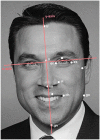Inferring Whether Officials Are Corruptible From Looking at Their Faces
- PMID: 30207833
- PMCID: PMC6249659
- DOI: 10.1177/0956797618788882
Inferring Whether Officials Are Corruptible From Looking at Their Faces
Abstract
While inferences of traits from unfamiliar faces prominently reveal stereotypes, some facial inferences also correlate with real-world outcomes. We investigated whether facial inferences are associated with an important real-world outcome closely linked to the face bearer's behavior: political corruption. In four preregistered studies ( N = 325), participants made trait judgments of unfamiliar government officials on the basis of their photos. Relative to peers with clean records, federal and state officials convicted of political corruption (Study 1) and local officials who violated campaign finance laws (Study 2) were perceived as more corruptible, dishonest, selfish, and aggressive but similarly competent, ambitious, and masculine (Study 3). Mediation analyses and experiments in which the photos were digitally manipulated showed that participants' judgments of how corruptible an official looked were causally influenced by the face width of the stimuli (Study 4). The findings shed new light on the complex causal mechanisms linking facial appearances with social behavior.
Keywords: corruption; face perception; open data; open materials; political psychology; preregistered; social attribution; stereotyping.
Conflict of interest statement
Figures






References
-
- Antonakis J., Eubanks D. L. (2017). Looking leadership in the face. Current Directions in Psychological Science, 26, 270–275.
-
- Berry D. S., Zebrowitz-McArthur L. (1988). What’s in a face? Facial maturity and the attribution of legal responsibility. Personality and Social Psychology Bulletin, 14, 23–33. - PubMed
-
- Blair I. V., Judd C. M., Chapleau K. M. (2004). The influence of Afrocentric facial features in criminal sentencing. Psychological Science, 15, 674–679. - PubMed
-
- Deska J. C., Lloyd E. P., Hugenberg K. (2018). Facing humanness: Facial width-to-height ratio predicts ascriptions of humanity. Journal of Personality and Social Psychology, 114, 75–94. - PubMed
Publication types
MeSH terms
Grants and funding
LinkOut - more resources
Full Text Sources
Other Literature Sources

